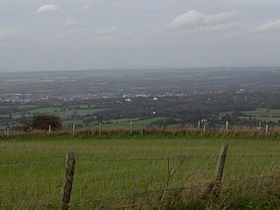- Ditchling Beacon
-
Ditchling Beacon 
Northward view from the summit of Ditchling Beacon, looking towards Hassocks and Burgess Hill. 27 October 2006.Elevation 248 m (814 ft) Prominence 213 m (699 ft) Parent peak Leith Hill Listing Marilyn Location Location South Downs, England Coordinates 50°54′02″N 0°06′25″W / 50.90056°N 0.10694°W Topo map OS Landranger 198 OS grid TQ331130  View from just south of the summit, looking towards the eastern side of Brighton. The road is named Ditchling Road at this point
View from just south of the summit, looking towards the eastern side of Brighton. The road is named Ditchling Road at this point
Ditchling Beacon is the third-highest point on the South Downs in south-east England, behind Butser Hill (270 m; 886 ft) and Crown Tegleaze (253 m; 830 ft). It consists of a large chalk hill with a particularly steep northern face, covered with open grassland and sheep-grazing areas. Situated just south of the East Sussex village of Ditchling and to the north-east of the city of Brighton, it is the highest point in the county of East Sussex. A road runs from Ditchling up and across the northern face and down into the northern suburbs of Brighton, and there are car parks at the summit and the northern base. Various charity, sporting and other events which are run regularly between London and Brighton incorporate this steep road as a challenging part of their route.
Contents
Location
The hill dominates the surrounding parts of the South Downs ridge, and particularly the much lower ground of the Lower Weald to the north (where the villages and towns of Mid Sussex are now located). This represents an excellent position for defensive purposes, and indeed it is known to be the site of an early Iron Age hill fort. A single defensive bank and ditch enclosed an area of approximately 5.5 hectares (13.6 acres). [1] Relatively little excavation of the fort has been carried out, however, and the existence of dew ponds, paths and tracks, as well as regular ploughing activity over the years, reduces the likelihood of any significant discoveries in the future.
Access
The only road access to the summit is via the steep and narrow Beacon Road, which runs from the centre of Ditchling village and takes the name Ditchling Road once the summit is reached and the descent into Brighton commences. Beacon Road connects with the B2116, which connects several villages close to the foot of the South Downs with the outskirts of Lewes, the county town of East Sussex. Underhill Lane, a minor road directly at the foot of the Downs, crosses Beacon Road adjacent to the car park. The road then commences its steep ascent, rising from 90 metres above sea level to the summit at 248 metres in just over 1.6 kilometres (one mile), and sweeping from side to side and around a number of sharp bends across the northern slope of the hill.
At the summit is a large car park, owned and operated by the National Trust (which also owns and manages approximately 1.6 hectares (4 acres) of land on the hill). Controversy occurred in November 2005 when a £2.00 charge for parking at this car park (and five others at National Trust-owned sites on the South Downs) was introduced.
From this point, Ditchling Road descends through open downland for approximately 4 kilometres (2.5 mi) until the edge of the Brighton built-up area is reached at Hollingbury. The road crosses the A27 Brighton Bypass and continues as a busy suburban road for more than 5 kilometres (3.1 mi) into the centre of Brighton.
The Brighton & Hove Bus and Coach Company, Brighton's main bus operator, has operated special services from locations in the city centre to Ditchling Beacon, via Ditchling Road, since 2002. Route 79, often operated using open-topped buses, originally ran during the summer only, but its increasing popularity means that as from 2006, some journeys have also been operated during the winter.
A footpath and bridleway runs across the ridge from east to west, taking in the summit; this forms part of the South Downs Way. Various footpaths and bridleways run down both the northern and southern slopes towards Brighton, Ditchling and other nearby villages such as Westmeston and Clayton. The road is considered too dangerous to walk along.
Access by rail can be achieved from Hassocks, from where a well-used path runs alongside the line to Clayton, at the western end of Underhill Lane. From here, access can be gained to several paths and bridleways leading up to Ditchling Beacon itself, or points slightly to the west on the South Downs Way.
Flora and fauna
A wide variety of plants can be found on Ditchling Beacon, especially during the summer. Flowers and herbs suited to chalk grassland, such as marjoram, thyme and certain types of orchid (notably the common spotted orchid), are often reported. (Some parts of the surrounding land are merely scrubland, however.) Butterflies are common; a notable example is the Chalkhill Blue, which is particularly well suited to uncultivated chalk downland areas. Some parts of the hill and the surrounding fields (particularly Ditchling Down, a large open area near the base of the northern face, close to the Beacon Road car park) are used for the grazing of sheep.
External links
Categories:- Hills of East Sussex
- Marilyns of England
- Lewes
Wikimedia Foundation. 2010.
